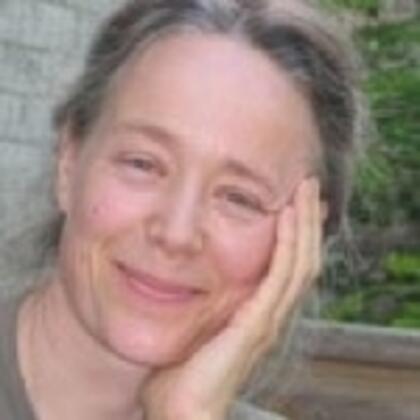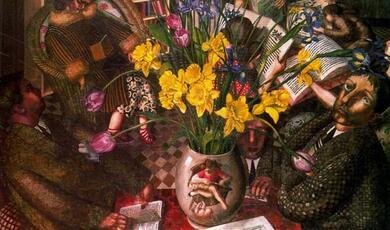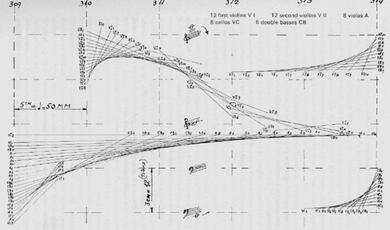What Is Literary Value?
Share
- Details
- Text
- Audio
- Downloads
- Extra Reading
Most people have little idea of what literary value is, yet we cannot learn about literature that does not get into print. This lecture looks at publishing as a capital-intensive industry with a structure of editors and readers trained to gauge audience reception and marketing possibilities. Publishers rarely take risks, yet it takes a long time to learn how to read writing from cultures and places outside the ones we have been trained to recognise.
Writers who will be discussed include Arthur Miller, Sylvia Plath, Nadine Gordimer, Derek Walcott and Nayantara Sahgal.
Download Text
15 October 1997
What is Literary Value?
Professor Lynette Hunter
What is literary value? That is the question I will be asking throughout these lectures, although they are not particularly linked in any other way. For this first lecture, I would like to raise a few direct and immediate questions related to ‘What is literary value?’ Do you read any more? If you do, how do you choose what you read? Do you ever get the sense that someone is choosing for you?
I do not expect a specific answer, either from today’s questions, or from the larger issue of value. Throughout the recorded history of writings about literature, oratory, story-telling, or the verbal arts in general, it has never been the case that people have found a specific answer. One of the earliest texts on oratory, storytelling and the then new custom of writing, talks about the way that we only find what we value through the interaction between speaker and audience, writer and reader: those communities that lie behind the word ‘communication’. That idea, of interaction, comes from Plato’s Phaedrus. This will be one of the few references I make to Rhetoric, under which name these lectures are given. But since I am a student of rhetoric, let me set the record straight: rhetoric is for me, the art of persuasion. In everyday English we tend to think of ‘rhetoric’ as manipulation, coercion and complexity - persuasion to do things we don’t want to, and hence, bad. But persuasion is also toward ‘good’ action. We can never take for granted that people will know what a ‘good’ action is. I hope we have all had the experience of changing our minds, with the attendant grim sense of humiliation or possibly the joyous ‘thank God I found that out before I did it’. Or, remember the horror and disgust at the projected floggings in Saudi Arabia a few weeks ago, and the equally forceful surprise from Saudi Arabia that people in England did not seem to want justice to be done. Rhetoric is there precisely to deal with such differences. Not to ignore them or eradicate them, because sometimes differences have to remain for a time and we need ways of continuing to talk to each other, but there to provide the possibility of negotiation and discussion.
During the Renaissance, there was an interesting way of differentiating rhetoric from logic, which is also persuasive. Logic was symbolised by the ‘closed fist’, a fist possibly of anger, or aggression, and certainly closed in upon itself, in its own world. In contrast, rhetoric was symbolised by the ‘open hand’, the hand that gives, or that shakes hands, even with people we are not sure we trust. You can see this close to home in young children who cannot get their way over something because they cannot explain or get it into the right words. They stand there, tense fists at their sides, clenched and frustrated. Of course, as they learn how to articulate, to discuss, it is often the adults who then stand with clenched fists, feeling outwitted and sometimes correctly. But learning those skills with words is learning about rhetoric. Rhetoric’s open hand always tries to form a community of communication.
I have said rather a lot about rhetoric because it is fundamentally tied to value. It is the way people argue over, worry about and, frequently, come to decisions about value, so that they can act and do things. But for writing today, for the whole range of how we use words, value is a problem.
If I were to ask you to write down on a piece of paper the four most important writers in your life, you would probably want first to know what the list was for- education? Revelations about your inner life? Representing your culture to another’s? If the list were for education, I can almost guarantee that there would be a high level of consistency. When I have asked other groups about this, they invariably come up with Shakespeare, one 19th century novel, one Romantic poet and usually a modernist like James Joyce. The choice reflects the ‘canon’, that set of authorised and authorising texts about which I shall say more in a moment. If the list were for revealing inner life, it would be bound to be much more varied, although I would guess that there would be quite a bit of consistency depending on your age or cultural background. But if the list were for reaching out to another community and saying, this is our best, or this best conveys what we value, would we choose important texts on the basis of style? or narrative? or culture? How could we not put Shakespeare’s writing on the list, even if we are not English? All over the English-speaking world, except the United States, there have been schemes of education modelled on the ‘O’ level or GCSE, and the ‘A’ level, to which Shakespeare has always been central, even in India, Canada or Jamaica. Claire Harris, from Trinidad and Tobago says:
“We studied the British syllabus, then wrote exams set and marked in England. We learned English folk songs, put on Gilbert and Sullivan. British gym mistresses taught us Morris dancing among other survival skills.”
Read for example the poem by Derek Walcott, Ruins of a Great House, which is filled with references to, among other, Horace and Shakespeare and John Donne. So, even if we work in a very different cultural world, can we leave out those common grounds for understanding? And if we do include them, how do we make room for the other more immediate stories, songs and poems?
What gets into and what stays out of the canon is largely decided by an interlocking relationship between education and publishing, and I will now go on to talk about each of these. First, education. When Matthew Arnold, in the 1860s to 70s, along with others, proposed and saw through the passing of the Education Acts, he was faced with, among many other things, a problem of what the pupils were to learn. The 1870s were in effect revolutionary: suddenly, within 10 years, every city, town, village, hamlet, in England had to teach its young people between the ages of 6 to 12. Space had to be found; in many places schools were built, and are still with us causing problems today; children had to be habituated to going to school, teachers had to be found, and decisions had to be made about what to teach. The teachers were frequently women, or impoverished men, neither with sufficient income to buy several copies of individual authors, so Arnold and his associates compiled a textbook, an anthology of the texts thought most appropriate for teaching the young people of England, and of course making it possible to examine them all on the same basis.
Arnold’s anthology brought together valued literature for teaching. It contained among other things, work by Shakespeare, Pope, the Romantic poets who had been so influential on Arnold’s generation, and, writing by his friends: Tennyson, Browning and himself. It was class specific to the upper middle classes (with the exception of Shakespeare), and it was wholly writing by men. This should not surprise us. Arnold after all lived in a period when the value of English writing was going through enormous upheaval. Writing of any kind takes education and time, and if you are writing to earn a living time is short. As you probably know, it was only in 1709 that writers were legally recognised as having any right over their published writing; when copyright was invested in the writer, the writer became an author and could control the money earned from their writing. Yet it was not until the late 19th century, only about 100 years ago, that they really started to do so. Although writers today would no doubt claim that they were not paid sufficiently.
That writers started to be paid a reasonable wage was one of the many revolutions brought about by Charles Dickens, himself the archetype of the lower middle class man ‘made good’. One of the best known examples of his help was the contract negotiation he worked on with Mrs Gaskell. She had received a pittance for her first book, but went on to make £200 for the second - still not much by Dickens’ standards, but no mean sum. Curiously enough, it was during the latter part of the 19th century that writing in English came to be valued so highly that it could be taught for the first time in universities along with the classics. Writing for money had been long-despised, even putting your name on a piece of writing was not considered correct in those days before the writer self-consciously attempted to create a media personality that would turn them into a commercial entity. Broadside ballads or chapbooks, the cheap-books carried rolled up by peddlers along with their buttons and ribbons, was not ‘literature’, and the people who wrote it probably did not have much time to spend re-writing and polishing; the time they spent writing was not leisure but work. So, prior to the end of the 19th century, most of the valued English writing was written by people with education, time and money.
Arnold’s canon remained in place for 50 years, until after World War I and another extraordinary decade, the 1920s, years of swift widening of the franchise. 1929 was the year when England finally attained adult enfranchisement, and again, for someone my age, born shortly after the second World War, it requires an act of imagination to understand what that rather dry ‘fact’ might mean to people. It is an experience that fascinates me, and from my readings over many years of texts from that period, I would suggest that people not only felt an extraordinary excitement because of the way a ‘vote’ was seen as an access to political power, but also that they felt they had a right to access cultural power. Certainly during this time F R Leavis along with T S Eliot and others, set about reforming the canon. They added women, for example Jane Austen and George Eliot. They added writers from different class positions such as Thomas Hardy and D H Lawrence. And they added some of their friends, including T S Eliot.
That canon is still largely in place, 70 years later. Nearly every ‘A’-level student reads some Shakespeare, possibly some Chaucer, and maybe some Pope, usually a Romantic poet and always a 19th century novelist, and then one or two 20th century writers. It is quite extraordinary though, that there are few texts from the major treasury of English-language literature in the United States, and rarely any from the immense wealth of English-language writing from Commonwealth countries. Americans in the canon include Sylvia Plath and Arthur Miller, and it is interesting to speculate about why they are there. Plath, one supposes, because she lived in England, wrote here, married here (famously), died here and is buried here. Perhaps she counts as English, and certainly more so than say James Joyce or Samuel Beckett. More to the point may be the way in which her life and death were presented to English society. Recent studies of her literary fame point out the way that media interest turned an undeniably good poet into someone who could stand for a generation of women.
Arthur Miller is more of a problem. Miller, along with Eugene O’Neill and Tennessee Williams, had plays produced in this country all through the decade immediately following the second World War, when, arguably, there was little new happening in English theatre. But after a further decade, this time of silence, at the end of the 1960s when American Studies were taking off, it was Miller who entered the canon with his plays The Crucible and Death of a Salesman. Miller may have been adopted because his plays are comparatively accessible. You only have to remember that The Crucible was produced in this country the same year as Beckett’s Waiting for Godot to recognise the conventional, almost 19th century technique in Miller’s work. Also, I suggest, the subject matter of his plays was considered more appropriate for young people. The issues in The Crucible,about what dreadful things people do when given access to power, are more palatable than the overt portrayals of sex and violence in O’Neill and Williams. But again, the unique aspect of Miller, is that he created an image for himself. After all, he had been married to Marilyn Monroe; he had mixed with the great and the good in American politics; he self-consciously carved out a role for himself in the civil rights world of the 1960s, as a social commentator, for example, retrospectively constructing The Crucible as a play about McCarthyism when it predated that period. One of his directors, Elia Kazan, suggested that he was simply trying to cover up the fact that the play was about a failed marriage. His timing was impeccable, for his productions returned to England just in time to catch the wave of interest in American Studies, and in a time of financial leniency that even saw a Centre for Miller Studies set up at the University of Essex.
Despite these and a few other additions, there has not been a lot of movement in the canon, nor is there much overt debate. Yet I cannot over-emphasise its importance: we train all our young people to read by way of these writers; they acquire most of their sense of literary value and aesthetic taste from these writings. Yet in this country of extraordinary diversity of verbal cultures, we rarely include others, even though we are very good at claiming the Scots and the Irish as English in order to do so. There have been open and vociferous debates in the United States, in France, in the Netherlands, in Spain, in Canada, about the canon, but not here. In the American debate that has continued to flare up at least since 1990, Frank Kermode has come out with implacable statements on ‘literary value’ and how to identify it. He has faced equally implacable opponents from the black community or the community of women’s studies, so that some universities in the States teach, for example, only literature from the black communities. They fight it out in the pages of the New York Review of Books and elsewhere. But here, Alistair Fowler’s statement from the 1980s, that if women had written anything worth reading it would already be in the canon, has simply not been taken up.
There is no debate about why the work of a major English language writer from India, Nayantara Sahgal, is not in the canon in England - although she will be speaking here in Gresham College on 1 December. Sahgal, who could be compared to a more visible and engaged Indian version of Doris Lessing, has produced work which stems from the 150 year tradition of English language writing in India. Her writing is part of a common cultural base not only for Asian-Indian writers in India and here, but also for several generations of English writers and readers who recognise the need to understand a part of their cultural heritage. However, neither the cultural mediators, nor the educational and publishing institutions that maintain that mediation, know how to value her writing. It may even be the case that their current activities prevent that valuing. She herself says that, “the publicity, the hype, the commerce surrounding [a novel] are so relentless that this most magical way of passing one’s time has been relegated like all else - like music, art, and sport - to the status of merchandise, and ourselves to one more form of bombardment”.
The canon is necessary for education partly, they say, to ensure equable examinations, largely because it offers a common cultural ground for people so that if, for example, you want to explain something by referring to a story or a poem, the person you are speaking to can understand your point, but also because in the end you cannot read everything. So how do you choose? Well, on the whole, we allow the canon to choose for us. Possibly more telling, the canon is necessary for publishing. So many of the criteria by which people decide on literary value are at root to do with publishing.
Look for example at the Orange Book Prize debate of the early summer this year. The Orange Book prize is a prize awarded to a book, in English, written by a woman. Last summer the debate started because someone in the New Statesman complained that publishing was being taken over by women: women editors, women publishers, women readers and now women writers. Lisa Jardine, an eminent scholar at Queen Mary and Westfield, defended the prize, pointing out that women frequently get left off other lists, which is indeed the case, and saying that the prize was a celebration of the richness and variety of women’s writing. And she has a point; after all there would not be the same complaints about say a prize for writing by people from the black community. But, she then went on to say that men’s writing in England was parochial and limited, of no interest to anyone outside a very small world. This of course attracted swift retaliation and questions like: shall we then give the world a literary equivalent of Benny Hill? Jardine responded, at one point saying that it was all right for Jane Austen to be parochial because most people lived in that way then....but do not do so now. The Orange Book Prize debate was rather like the American canon debate, but in effect it was all about publishing. However, my point is that implicitly behind all the arguments was the idea that eventually we could agree on who was right. We would, in the end, know who was right about value.
I do not think that value works like this anymore, if it ever did, because now we lack the rules of thumb for deciding what to read. We do not need to worry about the lack of agreement, but we do need to worry about the difficulty of determining value for ourselves.
England is a nation of scribblers. Nearly everyone is the country can write and if they cannot we get very worried about it. We train young people for 10 years of their early life, 5 to 15 or 16 years of age, to read and write. In the process they learn not only how to fill in licence applications and read cinema listings, but also about the canon and canonical value. Yet there are hundreds of thousands of people every year who try to get into print. Not only with letters to newspapers, which I happen to think an immensely difficult literary form, but full size books: novels, travel writing, cookery, sport, poetry, politics, biography. And the result is: that there is so much there that it is frightening. Wherever I travel at the moment I find that even book reviewers, critics and writers reading around their own work, are saying that they just cannot keep up. Perhaps this is why we still pay attention to the Booker Prize: the judges are supposed to have read so much.
What is your experience of bookshops these days? The sheer enormity of Waterstone’s or Bargain Books, where they try to control your sense of being overwhelmed by categorising books, creating physically small spaces for science fiction, or poetry, or humour, or philosophy. I am sure that is one of the reasons we continue to go back to the same shop, because they become familiar and relatively secure in the face of the enormity of publication. But they are a far cry from those small, often dark and frequently slightly seedy bookshops described so well by George Orwell’s Keep the Aspidistra Flying, where you had a personal relationship with the impoverished owner and may even have kept an account. I have to admit that, faced with so many books, I do buy a book at times by its cover. I read the reviews on the back, nervously aware that they may all have been written by friends of the author, I go through the inside back flap about the author trying to work out if they have a life interesting enough to write about something interesting, and know all the while that this is of course walking into manipulation by the publisher’s marketing designer. But it works. Look for example at the difference between the covers of two publishings of Margaret Laurence’s The Diviners: completely different messages are sent out by one, which has a sober dark green cover with an elegant illustration on the front, and the other, which appears to be a kind of Mills and Boon lookalike. Or, consider the first tin foil cover, found on Jeffrey Archer’s Kane and Abel. I used to think that tin-foil would never get on to ‘serious’ books until the recent Rushdie-West collection of Asian-Indian literature out this summer.
And so, to publishers: The circle of publishing relations looks something like this:
Publishing, until very recently, has, of necessity, been a capital-intensive industry. If you are a publisher, you have to put all your money upfront to produce books that possibly no one will buy. Because of the way that books are printed, it has not made sense to produce a few and test the market, so you need to decide from the start whether you will print 300 or 3,000 or 300,000. So publishers have to be very sure of their markets, and of their products. When a writer submits a manuscript, the publisher’s editor will decide if it fits in with other things the publisher is selling on their list. They may send the script right back, or they may send it out to publishers’ readers who are asked for an opinion. On the basis of that response, they may ask the writer to rewrite, recast, excise whole sections, and so on. Eventually it comes back, and the publishers can go through the procedure of copy-editing, design and production. But publishers and booksellers work in close co-operation. During the 19th century, the massive circulating library called Mudie’s was the final arbiter on any literary book. Publishers regularly sent Mudie’s upcoming scripts, to ensure that Mudie’s would take them into their stock, hence guaranteeing a profit. If Mudie’s Readers objected to elements in the script, such as the colour of the heroine’s hair, the entire character of the villain, or the language used, then back it would go to the writer for changes. These days similar exchanges still take place between certain high street booksellers and publishers. Even if the book is a ‘classic’ it may need editing for the present day. In fact, publishers do not on the whole like producing classics unless there is a very good reason, such as a film version coming out. There needs to be a definite cultural impetus to bring them back, and the strongest impact is made by education. The canon is very good at this, in fact it is usually only the things in the canon that get reprinted. An excellent example is the gradual trawl toward popularity of books by the Brontes. Part of the result of women being allowed to take university degrees (only in 1949 at Cambridge), meant that women got jobs in universities, and by the 1970s were beginning to ask why it was mainly writing by men that was taught. As a direct result of that institutional change, people went searching for classics by women writers, and found, or re-discovered, the Brontes. Wuthering Heights,Jane Eyre and the rest, are now staple parts of the canon, and publishers, seeing the thousands of copies that could be sold because required for a course, have responded to demand. But they are not very good at being pro-active, and find it extremely difficult to be so with new writers.
New writing in England, in any period of the time since the Renaissance, has had a very specific function. Like any other artist, the writer is a licensed critic, traditionally given the leeway to have a long and critical look at society, to satirise its conventions, to be subversive, to question and challenge, and, ultimately to construct new ways of looking at the world that society comes to value and eventually to use in shaping new conventions, new rules of thumb for behaviour. So, by definition, writers are not necessarily writing in ways that the audience will easily recognise. Indeed, among the many definitions for ‘literature’ as opposed to any other writing, is that it uses language in a way that is different from the familiar; hence ‘popular’ writing is not literature because it plays toward convention often because the writer needs to make money. Only those who do not depend on writing for their living can afford to alienate their audience. This begs the question of how readers read, for they may make conventional writing ‘literature’ by reading it differently. What is interesting is that as these writers become recognised, as their challenge to convention becomes valued, they enter the canon. The canon is thus a curious and potentially explosive paradox of change and subversion controlled within the legitimating walls of education and publishing.
As I indicated earlier, writers of valued literature whose work ended up in the canon, initially wrote from their own experience, their own needs and their own vision. The writing carried out a very important political function by waking people up to questions that needed to be asked and values that needed to be affirmed. Yet they did so within their experience, addressing issues and hopes specific to that group. Now, although the group from which they came was powerful, just as the politicians who claimed to represent the people while they really only represented a small group, just so the artists also only represented a small group of people. Until well into this century, publishers like educators, seemed to have much less of a problem in assessing value. As Nayantara Sahgal says, “present writing may well be an elite rehearsal for the more representative performance yet to come”. Granted, there were still too many books to publish but at least the audience was more or less defined, and you knew who you could get to review things. But now artists come from all segments of society, from different class positions, with different gender positions, and with different colours of skin. These new writers write about their concerns but do not necessarily claim to represent their audience, nor, if they are writers new to England, would it make much sense to us if they did. Rather they frequently work by opening the door to discussion within their communities, and potentially among other communities. I would suggest that writers or poets are no longer Shelley’s legislators of the world, but rather, negotiators of the local. This requires a rather different approach to literary value.
Canons need to be there, although we need new ways of negotiating them, but we also need to create new ways of valuing and of reading for new situations. In a rather British way, the educational system has been slowly changing the canon - certainly in universities, more slowly in A-Level syllabuses - with an impact on publishing that means that the general reader sees new books. It’s almost surreptitious. Yet while it may work for the people who value new reading communities, surreptitiousness does not necessarily help to encourage discussion among different communities. That discussion and negotiation has actively to be learned, rather that conventionally accepted. We do not want simply to pay lip service to other writing communities, for this becomes a kind of populism that accepts that there are a lot of different standards in a lot of different places, while evading any attempt to try to work on what might be valued in that other writing, how it might communicate, or not, with our own. Value is not something universal that we will all agree to, but something we work on within local settings - something we can participate in not simply ‘receive’.
How do we find those settings? That’s a difficult question, and I hope in some of the later lectures to address that issue, while challenging many of the grounds we take for granted in literary value.
© Lynette Hunter 2012
This event was on Wed, 15 Oct 1997
Support Gresham
Gresham College has offered an outstanding education to the public free of charge for over 400 years. Today, Gresham College plays an important role in fostering a love of learning and a greater understanding of ourselves and the world around us. Your donation will help to widen our reach and to broaden our audience, allowing more people to benefit from a high-quality education from some of the brightest minds.


 Login
Login







